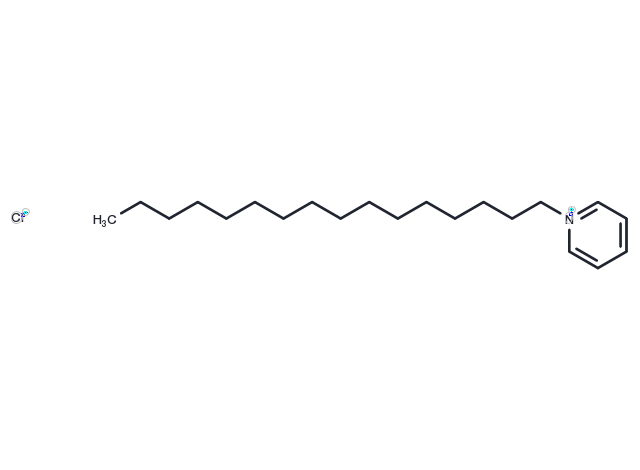Powder: -20°C for 3 years | In solvent: -80°C for 1 year


Cetylpyridinium Chloride (Hexadecylpyridinium Chloride) is a cationic quaternary ammonium compound used as oropharyngeal antiseptic.

| Pack Size | Availability | Price/USD | Quantity |
|---|---|---|---|
| 1 g | In stock | $ 30.00 | |
| 1 mL * 10 mM (in DMSO) | In stock | $ 29.00 |


| Description | Cetylpyridinium Chloride (Hexadecylpyridinium Chloride) is a cationic quaternary ammonium compound used as oropharyngeal antiseptic. |
| Targets&IC50 | HBV capsid assembly:2.5 μM (IC50) |
| In vitro | Cetylpyridinium chloride (CPC) as active ingredient of antiseptic oral mouthrinses has a broad antimicrobial spectrum with a rapid bactericidal effect on gram-positive pathogens and a fungicide effect on yeasts in particular. Application of CPC at a concentration of 0.05% as a mouthrinse results in an immediate reduction in bacterial counts of 2.0 to 2.5 log steps (which is adequate to > 99%). This reverts to about 1 log step (= 90%) 1 h after application. The ability of CPC to inhibit plaque and thereby reduce gingivitis is assured. In comparison to chlorhexidine, CPC has a lower residual effect, and as a result a lesser effect against plaque and gingivitis. The efficacy of CPC against oropharyngeal candidiasis is assured. CPC mouthrinses can significantly reduce infectious aerosols in dental practice, thereby protecting both staff and the patient. The balance of intra-oral bacterial flora is not disturbed even in the case of relatively long-term use of CPC (up to six weeks). [1] |
| In vivo | Cetylpyridinium chloride increases the risk of severe allergic reactions, such as swelling of the mouth, face, lips or tongue, labored breathing, rashes, and hives. Ingesting high concentrations of cetylpyridinium chloride can lead to lung damage. Cetylpyridinium chloride is toxic if swallowed or inhaled. [2] |
| Synonyms | Cetamium, Pristacin, Hexadecylpyridinium Chloride |
| Molecular Weight | 339.99 |
| Formula | C21H38N·Cl |
| CAS No. | 123-03-5 |
Powder: -20°C for 3 years | In solvent: -80°C for 1 year
H2O: 62 mg/mL (182.4 mM)
Ethanol: 63 mg/mL (185.3 mM)
DMSO: 63 mg/mL (185.3 mM)
You can also refer to dose conversion for different animals. More
bottom
Please see Inhibitor Handling Instructions for more frequently ask questions. Topics include: how to prepare stock solutions, how to store products, and cautions on cell-based assays & animal experiments, etc.
Cetylpyridinium Chloride 123-03-5 Microbiology/Virology Others HBV Antibacterial Cetylpyridinium assembly quaternary Inhibitor anti-bacterial ammonium inhibit Cetamium mouthwashes cationic Hepatitis B virus replication Capsid pesticides Pristacin Hexadecylpyridinium Chloride Bacterial inhibitor
